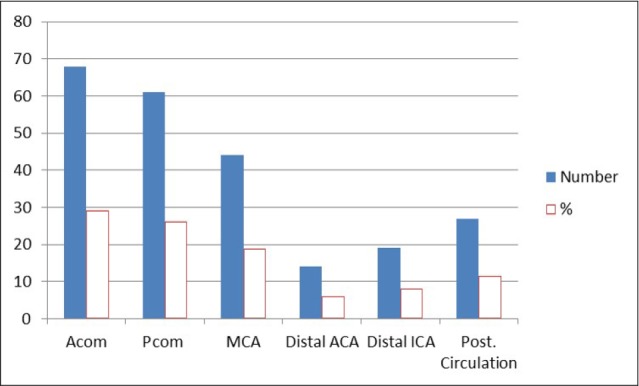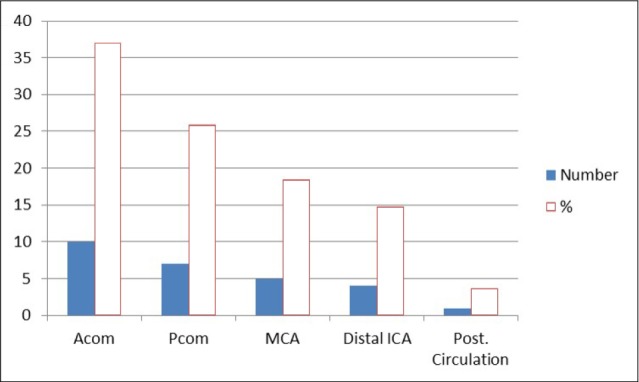J Cerebrovasc Endovasc Neurosurg.
2017 Sep;19(3):155-161. 10.7461/jcen.2017.19.3.155.
Endovascular Treatment of Symptomatic Vasospasm after Aneurysmal Subarachnoid Hemorrhage: A Three-year Experience
- Affiliations
-
- 1Department of Neurosurgery, School of Medicine, Institute of Wonkwang Medical Science, Wonkwang University, Iksan, Korea. kimdw@wku.ac.kr
- KMID: 2393497
- DOI: http://doi.org/10.7461/jcen.2017.19.3.155
Abstract
OBJECTIVE
The cause of severe clinical vasospasm after aneurysmal subarachnoid hemorrhage remains unknown, despite extensive research over the past 30 years. However, the intra-arterial administration of vasodilating agents and balloon angioplasty have been successfully used in severe refractory cerebral vasospasm.
MATERIALS AND METHODS
We retrospectively analyzed the data of 233 patients admitted to our institute with aneurysmal subarachnoid hemorrhage (SAH) over the past 3 years.
RESULTS
Of these, 27 (10.6%) developed severe symptomatic vasospasm, requiring endovascular therapy. Vasospasm occurred at an average of 5.3 days after SAH. A total of 46 endovascular procedures were performed in 27 patients. Endovascular therapy was performed once in 18 (66.7%) patients, 2 times in 4 (14.8%) patients, 3 or more times in 5 (18.5%) patients. Intra-arterial vasodilating agents were used in 44 procedures (27 with nimodipine infusion, 17 with nicardipine infusion). Balloon angioplasty was performed in only 2 (7.4%) patients. The Average nimodipine infusion volume was 2.47 mg, and nicardipine was 3.78 mg. Most patients recovered after the initial emergency room visit. Two patients (7.4%) worsened, but there were no deaths.
CONCLUSION
With advances in endovascular techniques, administration of vasodilating agents and balloon angioplasty reduces the morbidity and mortality of vasospasm after aneurysmal SAH.
MeSH Terms
Figure
Reference
-
1. Awad IA, Carter LP, Spetzler RF, Medina M, Williams FC Jr. Clinical vasospasm after subarachnoid hemorrhage: response to hypervolemic hemodilution and arterial hypertension. Stroke. 1987; Mar-Apr. 18(2):365–372. PMID: 3564092.
Article2. Barth M, Capelle HH, Weidauer S, Weiss C, Münch E, Thomé C, et al. Effect of nicardipine prolonged-release implants on cerebral vasospasm and clinical outcome after severe aneurysmal subarachnoid hemorrhage: a prospective, randomized, double-blind phase IIa study. Stroke. 2007; 2. 38(2):330–336. PMID: 17185636.3. Badjatia N, Topcuoglu MA, Pryor JC, Rabinov JD, Ogilvy CS, Carter BS, et al. Preliminary experience with intra-arterial nicardipine as a treatment for cerebral vasospasm. AJNR Am J Neuroradiol. 2004; 5. 25(5):819–826. PMID: 15140728.4. Bayer HealthCare: Important drug warning. 2006. 2.5. Bejjani GK, Bank WO, Olan WJ, Sekhar LN. The efficacy and safety of angioplasty for cerebral vasospasm after subarachnoid hemorrhage. Neurosurgery. 1998; 5. 42(5):979–986. discussion 986-7. PMID: 9588541.
Article6. Biondi A, Ricciardi GK, Puybasset L, Abdennour L, Longo M, Chiras J, et al. Intra-arterial nimodipine for the treatment of symptomatic cerebral vasospasm after aneurysmal subarachnoid hemorrhage: preliminary results. AJNR Am J Neuroradiol. 2004; Jun-Jul. 25(6):1067–1076. PMID: 15205150.7. Chan PD, Findlay JM, Vollrath B, Cook DA, Grace M, Chen MH, et al. Pharmacological and morphological effects of in vitro transluminal balloon angioplasty on normal and vasospastic canine basilar arteries. J Neurosurg. 1995; 9. 83(3):522–530. PMID: 7666232.
Article8. Dabus G, Nogueira RG. Current options for the management of aneurysmal subarachnoid hemorrhage-induced cerebral vasospasm: A comprehensive review of the literature. Interv Neurol. 2013; 10. 2(1):30–51. PMID: 25187783.
Article9. Dorsch NW, King MT. A review of cerebral vasospasm in aneurysmal subarachnoid haemorrhage: Part I: Incidence and effects. J Clin Neurosci. 1994; 1. 1(1):19–26. PMID: 18638721.
Article10. Elliott JP, Newell DW, Lam DJ, Eskridge JM, Douville CM, Le Roux PD, et al. Comparison of balloon angioplasty and papaverine infusion for the treatment of vasospasm following aneurysmal subarachnoid hemorrhage. J Neurosurg. 1998; 2. 88(2):277–284. PMID: 9452236.
Article11. Eskridge JM, McAuliffe W, Song JK, Deliganis AV, Newell DW, Lewis DH, et al. Balloon angioplasty for the treatment of vasospasm: results of first 50 cases. Neurosurgery. 1998; 3. 42(3):510–516. discussion 516-7. PMID: 9526985.12. Feigin VL, Rinkel GJ, Algra A, Vermeulen M, van Gijn J. Calcium antagonists in patients with aneurysmal subarachnoid hemorrhage: a systematic review. Neurology. 1998; 4. 50(4):876–883. PMID: 9566366.
Article13. Findlay JM, Nisar J, Darsaut T. Cerebral vasospasm: A review. Can J Neurol Sci. 2016; 1. 43(1):15–32. PMID: 26332908.
Article14. Firat MM, Gelebek V, Orer HS, Belen D, Firat AK, Balkanci F. Selective intraarterial nimodipine treatment in an experimental subarachnoid hemorrhage model. AJNR Am J Neuroradiol. 2005; Jun-Jul. 26(6):1357–1362. PMID: 15956497.15. Firlik KS, Kaufmann AM, Firlik AD, Jungreis CA, Yonas H. Intra-arterial papaverine for the treatment of cerebral vasospasm following aneurysmal subarachnoid hemorrhage. Surg Neurol. 1999; 1. 51(1):66–74. PMID: 9952126.
Article16. Griffith HB, Cummains BH, Thomson JL. Cerebral arterial spasm and hydrocephalus in leaking arterial aneurysms. Neuroradiology. 1972; 12. 4(4):212–214. PMID: 4677616.
Article17. Hoh BL, Ogilvy CS. Endovascular treatment of cerebral vasospasm: transluminal balloon angioplasty, intraarterial papaverine, and intra-arterial nicardipine. Neurosurg Clin N Am. 2005; 7. 16(3):501–516. viPMID: 15990041.
Article18. Horn J, Limburg M. Calcium antagonists for ischemic stroke: a systematic review. Stroke. 2001; 2. 32(2):570–576. PMID: 11157199.19. Kaku Y, Yonekawa Y, Tsukahara T, Kazekawa K. Superselective intra-arterial infusion of papaverine for the treatment of cerebral vasospasm after subarachnoid hemorrhage. J Neurosurg. 1992; 12. 77(6):842–847. PMID: 1432124.
Article20. Kassell NF, Helm G, Simmons N, Phillips CD, Cail WS. Treatment of cerebral vasospasm with intra-arterial papaverine. J Neurosurg. 1992; 12. 77(6):848–852. PMID: 1432125.
Article21. Kassell NF, Torner JC, Haley EC Jr, Jane JA, Adams HP, Kongable GL. The international cooperative study on the timing of aneurysm surgery. Part 1: overall management results. J Neurosurg. 1990; 7. 73(1):18–36. PMID: 2191090.22. Katoh H, Shima K, Shimizu A, Takiguchi H, Miyazawa T, Umezawa H, et al. Clinical evaluation of the effect of percutaneous transluminal angioplasty and intra-arterial papaverine infusion for the treatment of vasospasm following aneurysmal subarchnoid hemorrhage. Neurol Res. 1999; 3. 21(2):195–203. PMID: 10100208.23. Kazda S, Towart R. Nimodipine: a new calcium antagonistic drug with a preferential cerebrovascular action. Acta Neurochir (Wien). 1982; 63(1-4):259–265. PMID: 7102417.
Article24. Kirkpatrick PJ, Turner CL, Smith C, Hutchinson PJ, Murray GD. STASH Collaborators. Simvastatin in aneurysmal subarachnoid hemorrhage (STASH): a multicentre randomized phase 3 trial. Lancet Neurol. 2014; 7. 13(7):666–675. PMID: 24837690.25. Kobayashi H, Ide H, Aradachi H, Arai Y, Handa Y, Kubora T. Histological studies of intracranial vessels in primates following transluminal angioplasty for vasospasm. J Neurosurg. 1993; 3. 78(3):481–486. PMID: 8433153.
Article26. Kuwayama A, Zervas NT, Shintani A, Pickren KS. Papaverine hydrochloride and experimental hemorrhagic cerebral arterial spasm. Stroke. 1972; Jan-Feb. 3(1):27–33. PMID: 5008302.
Article27. Kwak R, Niizuma H, Ohi T, Suzuki J. Angiographic study of cerebral vasospasm following rupture of intracranial aneurysms: Part 1. Time of the appearance. Surg Neurol. 1979; 4. 11(4):257–262. PMID: 441910.28. Langham J, Goldfrad C, Teasdale G, Shaw D, Rowan K. Calcium channel blockers for acute traumatic brain injury. Cochrane Database Syst Rev. 2003; (4):CD000565. PMID: 14583925.
Article29. Lennihan L, Mayer SA, Fink ME, Beckford A, Paik MC, Zhang H, et al. Effect of hypervolemic therapy on cerebral blood flow after subarachnoid hemorrhage: a randomized controlled trial. Stroke. 2000; 2. 31(2):383–391. PMID: 10657410.30. Macdonald RL, Kassell NF, Mayer S, Ruefenacht D, Schmiedek P, Weidauer S, et al. Clazosentan toovercome neurological ischemia and infarction occurring after subarachnoid hemorrhage (CONSCIOUS-1) : randomized, double-blind, placebo-controlled phase 2 dose-finding trial. Stroke. 2008; 11. 39(11):3015–3021. PMID: 18688013.31. Mindea SA, Yang BP, Bendok BR, Miller JW, Batjer HH. Endovascular treatment strategies for cerebral vasospasm. Neurosurg Focus. 2006; 9. 21(3):E13.
Article32. Murai Y, Kominami S, Kobayashi S, Mizunari T, Teramoto A. The long-term effects of transluminal balloonangioplasty for vasospasms after subarachnoid hemorrhage: analyses of cerebral blood flow and reactivity. Surg Neurol. 2005; 8. 64(2):122–126. discussion 127. PMID: 16051001.33. Newell DW, Eskridge JM, Mayberg MR, Grady MS, Winn HR. Angioplasty for the treatment of symptomatic vasospasm following subarachnoid hemorrhage. J Neurosurg. 1989; 11. 71(5 Pt 1):654–660. PMID: 2530321.
Article34. Ogata M, Marshall BM, Lougheed WM. Observation on the effects of intrathecal papaverine in experimental vasospasm. J Neurosurg. 1973; 1. 38(1):20–25. PMID: 4629882.35. O'Driscoll G, Green D, Taylor RR. Simvastatin, an HMG-coenzyme A reductase inhibitor, improves endothelial function within 1 month. Circulation. 1997; 3. 95(5):1126–1131. PMID: 9054840.36. Peroutka SJ, Allen GS. Calcium channel antagonist binding sites labeled by 3H-nimodipine in human brain. J Neurosurg. 1983; 12. 59(6):933–937. PMID: 6631515.
Article37. Pisani A, Calabresi P, Tozzi A, D'Angelo V, Bernardi G. L-type Ca2+ channel blockers attenuate electrical changes and Ca2+ rise induced by oxygen/glucose deprivation in cortical neurons. Stroke. 1998; 1. 29(1):196–201. PMID: 9445351.38. Rosenwasser RH, Armonda RA, Thomas JE, Benitez RP, Gannon PM, Harrop J. Therapeutic modalities for the management of cerebral vasospasm: timing of endovascular options. Neurosurgery. 1999; 5. 44(5):975–979. PMID: 10232530.
Article39. Sayama CM, Liu JK, Couldwell WT. Update on endovascular therapies for cerebral vasospasm induced by aneurysmal subarachnoid hemorrhage. Neurosurg Focus. 2006; 9. 21(3):E12.
Article40. Schmid-Elsaesser R, Kunz M, Zausinger S, Prueckner S, Briegel J, Stieger HJ. Intravenous magnesium versus nimodipine in the treatment of patients with aneurysmal subarachnoid hemorrhage: a randomized study. Neurosurgery. 2006; 6. 58(6):1054–1065. PMID: 16723884.
Article41. Schuknecht B. Endovascular treatment of cerebral vasospasm following aneurysmal subarachnoid hemorrhage. Acta Neurochir Suppl. 2005; 94:47–51. PMID: 16060240.
Article42. Shaw MD, Vermeulen M, Murray GD, Pickard JD, Bell BA, Teasdale GM. Efficacy and safety of the endothelinA/B receptor antagonist TAK-044 in treating subarachnoid hemorrhage: a report by the Steering Committee on behalf of the UK/Netherlands/Eire TAK-044 Subarachnoid Haemorrhage Study Group. J Neurosurg. 2000; 12. 93(6):992–997. PMID: 11117873.43. Stippler M, Crago E, Levy EI, Kerr ME, Yonas H, Horowitz MB, et al. Magnesium infusion for vasospasm prophylaxis after subarachnoid hemorrhage. J Neurosurg. 2006; 11. 105(5):723–729. PMID: 17121134.
Article44. Suarez JI, Tarr RW, Selman WR. Aneurysmal subarachnoid hemorrhage. N Engl J Med. 2006; 1. 354(4):387–396. PMID: 16436770.
Article45. Su SH, Xu W, Hai J, Wu YF, Yu F. Effects of statins-use for patients with aneurysmal subarachnoid hemorrhage: a meta-analysis of randomized controlled trials. Sci Rep. 2014; 4. 4:4573. PMID: 24763190.
Article46. Vajkoczy P, Meyer B, Weidauer S, Raabe A. Thome C. Ringel F, et al. Clazosentan (AXV-034343), a selective endothelin A receptor antagonist, in the prevention of cerebral vasospasm following severe aneurysmal subarachnoid hemorrhage; results of a randomized, double-blind, placebo-controlled, multicenter phase IIa study. J Neurosurg. 2005; 7. 103(1):9–17. PMID: 16121967.
- Full Text Links
- Actions
-
Cited
- CITED
-
- Close
- Share
- Similar articles
-
- Delayed Vasospasm after Aneurysmal Subarachnoid Hemorrhage in Behcet Syndrome
- Endovascular Treatment of Cerebral Vasospasm Following Aneurysmal Subarachnoid Hemorrhage
- Comparative Study of Cerebral Vasospasm between Endovascular Treatment and Conventional Surgery of Acutely Ruptured Aneurysms: Clinical Study
- Relation between Thromboembolism and Delayed Ischemic Neurological Deficits in Aneurysmal Subarachnoid Hemorrhage
- Evaluation of Subarachnoid Hemorrhage due to Aneurysmal Rupture and Cerebral Vasospasm by CT




